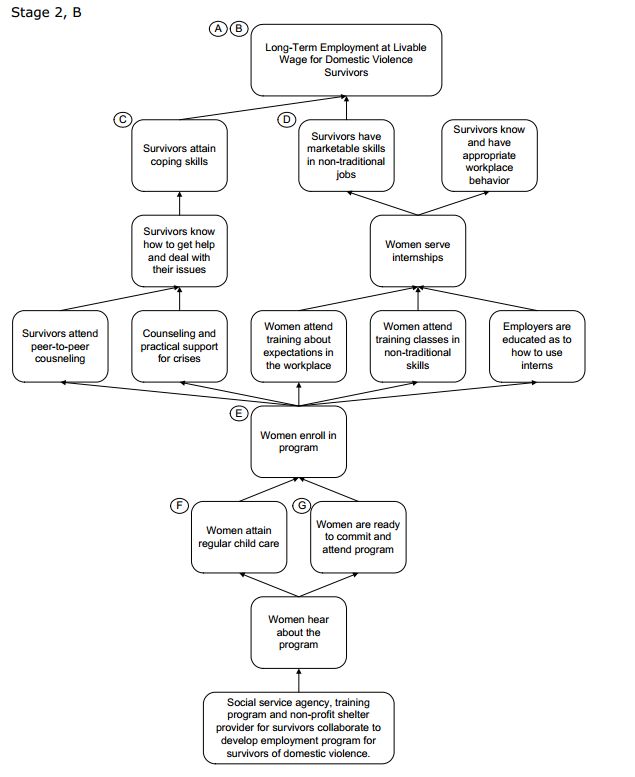A monitoring and evaluation framework is an important tool to set up a programme in a way that it can be more easily monitored and evaluated. This framework, should be accompanied by a plan that articulates the actual monitoring and evaluation processes that will be undertaken throughout the programming cycle. The plan should be developed during the planning and design phase of an initiative and provide an overview of what will be monitored (based on the programme framework); when monitoring will take place; the tools and resources that will be used in the process and the baseline data that will be collected against which the outcomes and impact of interventions can be measured.
The monitoring and evaluation framework is important to illustrate the linkages between programme inputs, outputs and outcomes and may be structured in different ways to reflect the individual shelter characteristics. Importantly, the framework should include a theory of change.
A theory of change for shelter programmes explains the logic of how specific activities or the approach is envisioned to contribute to the particular outcome or result the organization seeks to achieve. This theory of change accompanies a logical framework which articulates the pathways to this change and how they will be measured.
Developing a Theory of Change for Project Super Woman, New York (USA)
Project Superwomen was a collaborative initiative between a social service provider, a non-profit employment training center and a shelter provider in New York City. The project was established to assist women survivors of domestic violence in obtaining the type of employment that would keep them out of poverty and off public assistance, while providing them with stability and upward mobility. The initiative engaged evaluators, ActKnowledge and the Aspen Institute Roundtable on Community Change, to assist with the development of a theory of change.
The process involved several steps, including:
1. Identifying goals and assumptions
2. Backwards mapping and connecting outcomes
3. Developing indicators
4. Identifying interventions
5. Writing a narrative
In following this process, the team was able to construct a diagram demonstrating the logic behind how change would occur. The diagram below illustrates the resulting pathways to ensuring women survivors achieve long-term employment at a livable wage.

To read more about the process, access the full document in English.
In order to adequately monitor and evaluate shelter and related services, programme documents should clearly describe the theory of change and articulate additional information, including:
- Descriptions of programme recipients or beneficiaries, which might include women and their children or girls who are fleeing violence and who:
- Are seeking short-term safe housing and supports (i.e. emergency shelter)
- Have previously stayed in an emergency shelter but require longer-term safe housing and supports to reach their goals (i.e. transitional shelter/ accomodation)
- Are not currently choosing to access shelters and require safety and goal achievement supports (outreach services/ alternative accomodation)
- Definitions of programme inputs, which are financial and other resources required by shelters and related programming to deliver services. For example:
- Funding–provided by local governments, community foundations, federal organizations or private donors.
- Staff –including shelter reception or front-line staff, relief staff, volunteer coordinators or supervisors, administrators and managers.
- Volunteers – including those who engaged in various boards and committees and those who support services through donation management or transportation.
- Facilities – including the physical shelter infrastructure, office space and equipment.
- Definition of activities, which include all services and supports that a programme or shelter provides in order to achieve the desired outcomes, and may include:
- Arrival and assessment activities
- Safety planning
- Basic needs support and donations or other resources
- Individual counseling and support
- Women’s support groups
- Advocacy and referrals
- Child care and/or child support
- Follow-up services and outreach
- Definition of the outputs, or what the inputs and activities will produce/yield.
- Definition of the outcomes, or what is expected to change as a result of the inputs, activities and outputs.